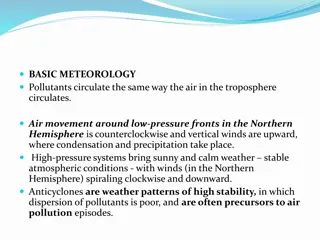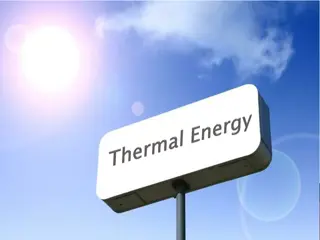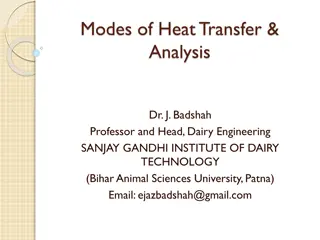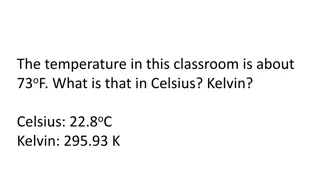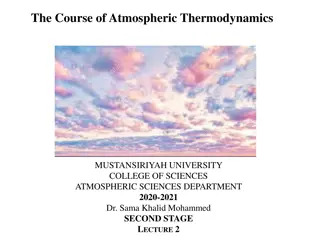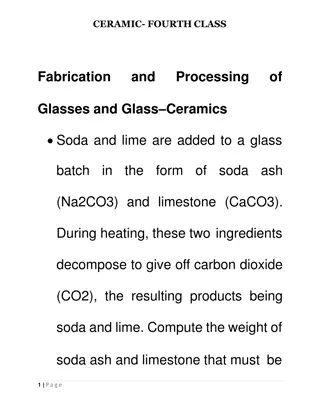Understanding Adiabatic Processes in Thermal Physics
Exploring the concept of adiabatic processes in thermal physics, this content delves into the adiabatic expansion of an ideal gas, the relationship between pressure and volume during such processes, and the characteristics of free expansion. President University's Dr.-Ing. Erwin Sitompul provides insights and visuals to aid in grasping these fundamental principles.
Download Presentation

Please find below an Image/Link to download the presentation.
The content on the website is provided AS IS for your information and personal use only. It may not be sold, licensed, or shared on other websites without obtaining consent from the author. Download presentation by click this link. If you encounter any issues during the download, it is possible that the publisher has removed the file from their server.
E N D
Presentation Transcript
Thermal Physics Lecture 6 Dr.-Ing. Erwin Sitompul President University http://zitompul.wordpress.com 2 0 1 8 President University Erwin Sitompul Thermal Physics 6/1
Chapter 19 Kinetic Theory The Adiabatic Expansion of an Ideal Gas An adiabatic process is a process for which Q = 0. We can ensure that Q = 0 either by carrying out the process very quickly or by doing it (at any rate) in a well-insulated container. The figure below shows a cylinder, now containing an ideal gas and resting on an insulating stand. By removing mass from the piston, we can allow the gas to expand adiabatically. As the volume increases, both the pressure and the temperature drop. President University Erwin Sitompul Thermal Physics 6/2
Chapter 19 Kinetic Theory The Adiabatic Expansion of an Ideal Gas The relation between the pressure and the volume during such an adiabatic process is: pV = a constant Adiabatic Process in which = CP/CV, the ratio of the molar specific heats for the gas. On a p-V diagram, the adiabatic process can be shown to occur along a line (called an adiabat) that has the equation: 1 = a constant) ( p V President University Erwin Sitompul Thermal Physics 6/3
Chapter 19 Kinetic Theory The Adiabatic Expansion of an Ideal Gas President University Erwin Sitompul Thermal Physics 6/4
Chapter 19 Kinetic Theory The Adiabatic Expansion of an Ideal Gas To write an equation for an adiabatic process in terms of T and V, we use the ideal gas equation (pV = nRT) to eliminate P: nRT V = V a constant Because n and R are constants, we can rewrite this in the alternative form: TV =a constant 1 Adiabatic Process President University Erwin Sitompul Thermal Physics 6/5
Chapter 19 Kinetic Theory The Adiabatic Expansion of an Ideal Gas Free Expansion Recalling to previous section, a free expansion of a gas is an adiabatic process that involves no work done on or by the gas, and no change in the internal energy of the gas. In a free expansion, a gas is in equilibrium only at its initial and final points. Thus, we can plot only those two points, but not the expansion itself, on a p-V diagram. In addition, Eint = 0, thus the initial and final point must be on the same isotherm. T T = Free Expansion i f If we next assume that the gas is ideal, then because there is no change in temperature, there can be no change in the product pV. Thus, a free expansion involves the relation: = pV p V Free Expansion i i f f President University Erwin Sitompul Thermal Physics 6/6
Chapter 19 Kinetic Theory Problem One mole of oxygen (assume it to be an ideal gas) expands at a constant temperature T of 310 K from an initial volume Vi of 12 l to a final volume Vf of 19 l. (a) What would be the final temperature if the gas had expanded adiabatically to this same final volume? Oxygen (O2) is diatomic and here has rotation but not oscillation. C C R R 7 2 5 2 = = = P 1.40 (a) = 1 1 TV T V i i f f V 1 V V = T T i f i f 1.40 1 12 19 = (310) = 257.9 K President University Erwin Sitompul Thermal Physics 6/7
Chapter 19 Kinetic Theory Problem One mole of oxygen (assume it to be an ideal gas) expands at a constant temperature T of 310 K from an initial volume Vi of 12 l to a final volume Vf of 19 l. (b) What would be the final temperature and pressure if, instead, the gas has expanded freely to the new volume, from an initial pressure of 2.0 Pa. = = 310 K T T (b) f i (12)(2) (19) V V = = = 1.263Pa i p p f i f President University Erwin Sitompul Thermal Physics 6/8
Chapter 19 Kinetic Theory Further Problem Rapid compression or expansion can be approximated as adiabatic process. It occurs at a very short time, which does not allow energy exchange between the gas and the environment. Suppose a mini bike pump rapidly compress a quantity of air with initial pressure is 105Pa and temperature of 22 C to a volume that is a quarter of its original volume. What is the final temperature? A513.6 K President University Erwin Sitompul Thermal Physics 6/9
Chapter 19 Kinetic Theory Four Gas Processes President University Erwin Sitompul Thermal Physics 6/10
Thermal Physics Chapter 20 Second Law of Thermodynamics President University Erwin Sitompul Thermal Physics 6/11
Chapter 20 Second Law of Thermodynamics Irreversible Processes and Entropy We are accustomed to one-way processes that is, processes that can occur only in a certain sequence (the right way). If you throw a stack of playing cards, they will spread apart. The other way around is hard to imagine. These one-way processes are irreversible, meaning that they cannot be reversed by means of only small changes in their environment. The key to understanding why one-way processes cannot be reversed involves a quantity known as entropy. Entropy is considered to be a measure of the system's disorder, that is a property of the system's state, and that varies directly with any reversible change in heat in the system and inversely with the temperature of the system. In a broad definition, entropy is the degree of disorder or uncertainty in a system.system President University Erwin Sitompul Thermal Physics 6/12
Chapter 20 Second Law of Thermodynamics Irreversible Processes and Entropy The one-way character of irreversible processes is so pervasive that we take it for granted. If these processes were to occur spontaneously, it will be strange, although none of these wrong-way events would violate the law of conservation of energy. The changes in energy within a closed system do not set the direction of irreversible processes. Rather, that direction is set by another property: the change in entropy S of the system. We can now state the central property of entropy (entropy postulate): If an irreversible process occurs in a closed system, the entropy S of the system always increases; it never decreases. President University Erwin Sitompul Thermal Physics 6/13
Chapter 20 Second Law of Thermodynamics Irreversible Processes and Entropy Entropy differs form energy in that entropy does not obey the conservation law. The energy of a closed system is conserved; it always remains constant. The entropy of a closed system always increases for irreversible processes. There are two equivalent ways to define the change in entropy of a system: 1. In terms of the system s temperature and the energy the system gains or loses as heat, and 2. By counting the ways in which the atoms or molecules that make up the system can be arranged. Both ways will be discussed in this chapter. President University Erwin Sitompul Thermal Physics 6/14
Chapter 20 Second Law of Thermodynamics Change in Entropy The free expansion of an ideal gas can be used to explain the definition of change in entropy. On the next figure, if the stopcock is opened, gas in its initial equilibrium state i will rush to fill the entire container, eventually reaching the final equilibrium state f. President University Erwin Sitompul Thermal Physics 6/15
Chapter 20 Second Law of Thermodynamics Change in Entropy Pressure, volume, temperature, and energy are state properties of a gas. They depend only on the state of the gas and not on how it reached that state. We now assume that the gas has still another state property its entropy. Furthermore, we define the change in entropy Sf Si of a system during a process that takes the system from an initial state i to a final state f as: f dQ S S S T = = Change in Entropy f i i President University Erwin Sitompul Thermal Physics 6/16
Chapter 20 Second Law of Thermodynamics Change in Entropy It will be difficult to analyze the change of entropy of a free expansion process since we do not know the exact path of the process, from i to f. But if entropy supposed to be a state property it only depends on initial state and final state, not on the path of the process then we can use an isothermal process from i to f to analyze the entropy. This is because we know previously, that free expansion occurs at constant temperature. We can now take the constant temperature T outside the integral: f 1 T Q T = = S S S dQ f i i = = S S S Change in Entropy, Isothermal Process f i President University Erwin Sitompul Thermal Physics 6/17
Chapter 20 Second Law of Thermodynamics Change in Entropy To summarize: To find the entropy change for an irreversible process occurring in a closed system, replace that process with any reversible process that connects the same initial and final states. Calculate the entropy change for this reversible process with: f dQ S S S T = = f i i When the temperature change T of a system is small relative to the temperature (in kelvins) before and after the process, the entropy change can be approximated as: Q S S S T = f i avg President University Erwin Sitompul Thermal Physics 6/18
Chapter 20 Second Law of Thermodynamics Checkpoint Water is heated on a stove. Rank the entropy change of the water as its temperature rises (a) from 20 C to 30 C, (b) from 30 C to 35 C, and (c) from 80 C to 85 C, greatest first. a, b, and c f dQ T = = S S S f i i President University Erwin Sitompul Thermal Physics 6/19
Chapter 19 Kinetic Theory Further Problem One kilogram of ice at 0 C is melted to become water at the same temperature. Calculate the entropy change, assuming that the melting occurs reversibly (LF,water= 333 kJ/kg). A1219.8 J/K President University Erwin Sitompul Thermal Physics 6/20
Chapter 19 Kinetic Theory Further Problem Two kilogram of water at 0 C is heated to 100 C. Calculate the entropy change, assuming that the process occurs reversibly (cwater= 4180 kJ/kg). A2609.2 J/K President University Erwin Sitompul Thermal Physics 6/21
Chapter 20 Second Law of Thermodynamics Class Group Assignments 1. A certain quantity of an ideal monatomic gas ( = 5/3) is taken around the reversible cycle shown below, where AB is an adiabatic process, and the temperature at A is 500 K. How much work is done in going from C to A to B? (a) 41 kJ (d) 66 kJ (b) 122 kJ (e) 181 kJ (c) 270 kJ 2. The temperature of n moles of a gas is increased from Ti to Tf at constant volume. If the molar specific heat at constant volume is CV and is independent of temperature, then the change in the entropy of the gas is: (a) nCVln(Tf/Ti) (d) nCVln(Ti/Tf) (b) nCVln(Tf Ti) (e) nCVln(1 Ti/Tf) (c) nCV(Tf Ti) 3. A hot object and a cold object are placed in thermal contact and the combination is isolated. They transfer energy until they reach a common temperature. The change Sh in the entropy of the hot object, the change Sc in the entropy of the cold object, and the change Stotal in the entropy of the combination are: (a) Sh>0, Sc>0, Stotal>0 (d) Sh>0, Sc<0, Stotal>0 (b) Sh<0, Sc>0, Stotal>0 (e) Sh>0, Sc<0, Stotal<0 (c) Sh<0, Sc>0, Stotal<0 President University Erwin Sitompul Thermal Physics 6/22
Chapter 20 Second Law of Thermodynamics Homework 6 1.(19-59) 2.(19-61) 3.(20-11) Deadline: Tuesday, 6 November 2018. Validation test will be conducted in the beginning of the class. President University Erwin Sitompul Thermal Physics 6/23



